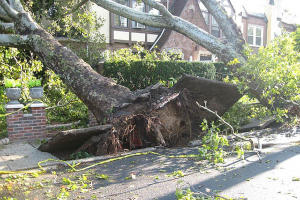Natural disasters in 2022: colossal claims amounts
 According to the broker Aon, the economic losses generated by natural disasters occurring between 1 January and 30 September 2022 amount to 227 billion USD. Almost 44% of this amount is insured, that is, 99 billion USD.
According to the broker Aon, the economic losses generated by natural disasters occurring between 1 January and 30 September 2022 amount to 227 billion USD. Almost 44% of this amount is insured, that is, 99 billion USD.
Half of the economic damages are listed in the United States, that is, about 114 billion USD. The Asia-Pacific region arrives in second position with 56 billion USD of economic damages, followed by the EMEA region (1) with 42 billion USD.
These amounts are higher than the average observed in the United States and in the EMEA region, while they are lower than the average in the Asia Pacific region. According to the "Global Catastrophe Recap Q3 2022" report published by Aon, the amount of economic losses for the first three quarters of the year 2022 is close to the average reported during the 21st century. On the other hand, the sum of insured claims during the same period is well above the average of the years 2000 to 2012, and close to the average of the last five years.
According to all the forecasts, a strong evolution of the amounts of natural disasters claims is to be expected in 2022. This loss ratio deterioration will be seen at two levels:
- at the level of recent tropical events already reported, notably because of the assumption of inflation.
- at the level of future events not yet reported in 2022. The hurricane season not yet closed may be affected by other events that would aggravate the situation of insurers and reinsurers. This aggravation is all the more feared as inflationary pressures are particularly high.
Primary perils
The natural disasters losses, called primary perils (2), occurred mainly during the third quarter of 2022.
Hurricanes hit the regions bordering the Atlantic and Pacific Oceans. Hurricane Ian, which hit Florida at the end of September, is considered to be the most expensive disaster of the year. This event has claimed the lives of 137 people (5 in Cuba and 132 in the United States), triggering economic losses of around 70 billion USD.
According to the CoreLogic research center, Ian is likely to set insurers back between 28 and 47 billion USD. Even if the final figures will not be known for several months, it is highly expected that Ian will be the most expensive storm to hit Florida since hurricane Andrew in 1992.
The Fitch Ratings agency estimates that the insured losses caused by Ian would range from 25 to 40 billion USD while Standard & Poor's is counting on an amount between 30 and 40 billion USD.
Finally, the firm Karen Clark & Company (KCC) came up with a more downbeat forecast of insured losses amounting to 63 billion USD.
Secondary perils
The first half of 2022 has been marked by so-called secondary perils (3) and in particular by floods and violent storms. Several countries were the scene of unprecedented climatic disasters. This was the case for the terrible floods that affected Australia and South Africa. In continental Europe, France experienced hailstorms that had never been seen before.
Swiss Re estimates the total cost of natural disasters of this type at 35 billion USD, up by 22% compared to the average of the last years. The floods in Australia alone are estimated at 3.5 billion USD. This is the most expensive flood event for insurers during the first quarter of 2022.
This growth of secondary risks is particularly worrying for reinsurers who are getting more and more reluctant to cover this type of risk due to its frequency and severity.
Exposure to high intensity losses
The insurance market is not only exposed to natural catastrophes. Other risks, notably pandemics and cybercrime, are increasingly weighing on the accounts and financial balances of insurers and reinsurers.
The market's exposure to cyber risks has grown exponentially over the last two years. This is evidenced by the increase in cyber-attacks around the world. The Association of Reinsurance Professionals in France (APREF) estimates that the cyber risk has increased by 50% in a very short period of time.
Finally, on the health front, the Covid-19 pandemic continues to weigh on the economic recovery.
All these phenomena have a common feature: they are no longer local events of moderate intensity but, on the contrary, risks of high frequency and intensity of a systemic nature.
(1) EMEA: Europe, Middle East and Africa
(2) Primary perils are natural disasters causing significant losses to the insurance industry. Example: hurricane, earthquake, ...
(3) Secondary perils result from a primary peril. These are medium-sized events linked to global warming, for example, flooding following a storm.
